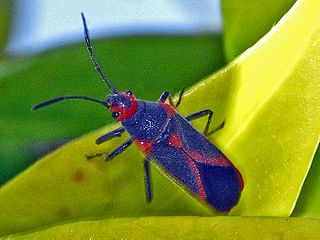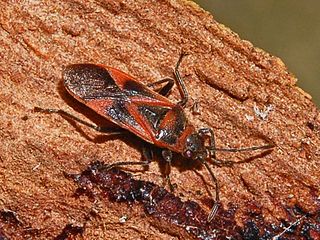
Pentatomidae is a family of insects belonging to the order Hemiptera, generally called shield bugs or stink bugs. Pentatomidae is the largest family in the superfamily Pentatomoidea, and contains around 900 genera and over 4700 species. As hemipterans, the pentatomids have piercing sucking mouthparts, and most are phytophagous, including several species which are severe pests on agricultural crops. However, some species, particularly in the subfamily Asopinae, are predatory and may be considered beneficial.

Ricaniidae is a family of planthopper insects, containing over 400 species worldwide. The highest diversity is in tropical Africa and Asia and in Australia, with a few species occurring in the Palearctic and Neotropical realms. It is one of the smaller families in the planthopper superfamily Fulgoroidea.

Rhynocoris is a genus of assassin bug, family (Reduviidae), in the subfamily Harpactorinae. Species are recorded from Asia, mainland Europe, Africa and North America.

The Blissidae are a family in the Hemiptera, comprising nearly 50 genera and 400 species. The group has often been treated as a subfamily of the Lygaeidae but was resurrected as a full family by Thomas Henry (1997).

Ischnodemus is a genus in the true bug family Blissidae. The review by Slater (1979) listed 95 species. The genus is found in all major zoogeographic regions, being most abundant on various species of Gramineae. The bodies of the adults are moderately to very elongated. The genus name was coined to refer to this slenderness, from the Greek ἰσχνόσ (ischnos) "feeble" and δέμασ (demas) "body".

Graptostethus is a genus in the insect family Lygaeidae. Although originally restricted to the Old World some species like G. servus have spread to parts of the New World.

Spilostethus is a genus of bugs in the family Lygaeidae. Most species in this genus are from the Palearctic and Oriental regions.

Lygaeinae is a subfamily of ground bugs in the insect family Lygaeidae.

Arocatus is a genus of bugs in the family Lygaeidae.

Oxycarenidae is a family of true bugs in the order Hemiptera. There are more than 20 genera and 140 described species in Oxycarenidae.

Carpocorini is a tribe of stink bugs in the family Pentatomidae. There are more than 100 genera in Carpocorini.

Pachygronthidae is a family of true bugs in the order Hemiptera. There are about 14 genera and more than 80 described species in Pachygronthidae.

Pochazia is a genus of true bugs belonging to the family Ricaniidae.

Cosmoscarta is a genus of froghoppers found in the Indo-Malayan region. Many of the species are boldly marked in black and red or yellow. A few species are of economic importance as they can cause injury to plants under cultivation.














